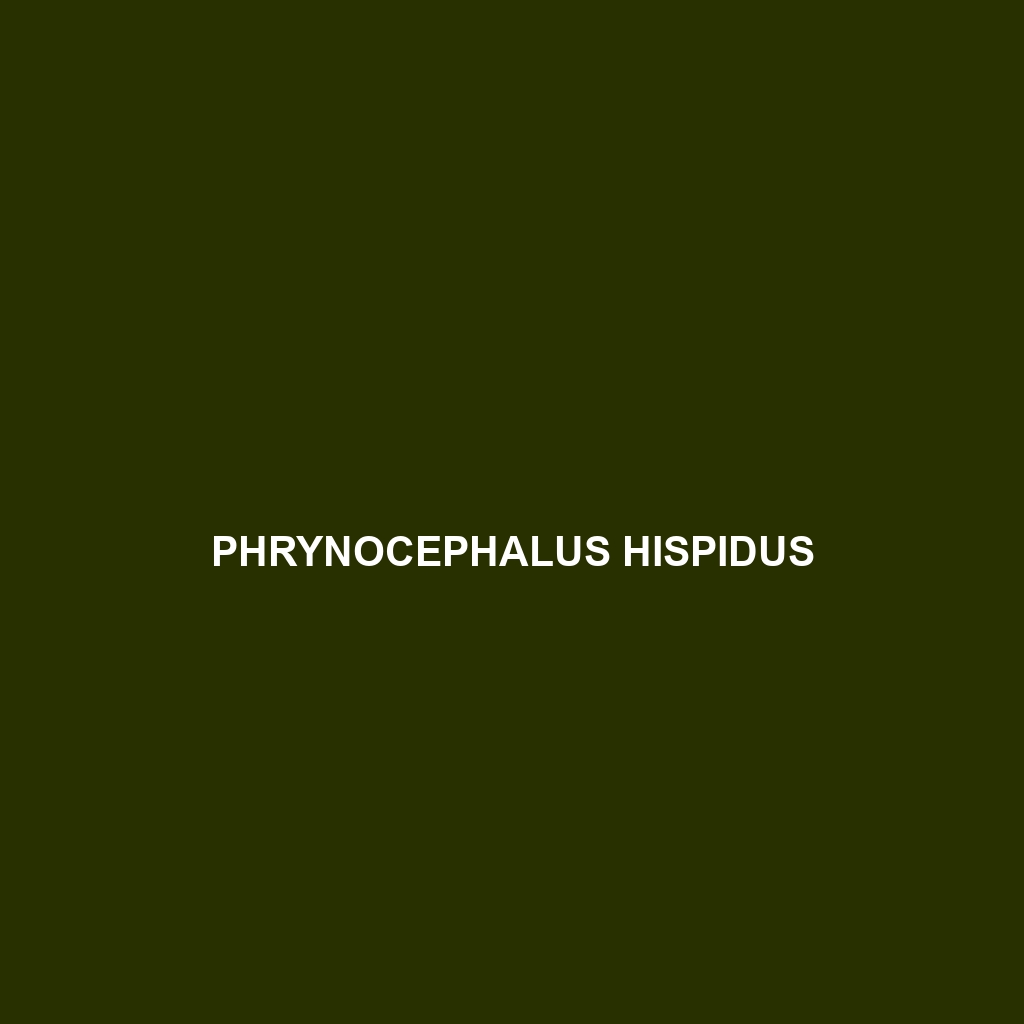Common Name
Phrynocephalus hispidus
Scientific Name
Phrynocephalus hispidus
Habitat
Phrynocephalus hispidus, commonly known as the hispid toad-head agama, primarily inhabits the arid regions of Central Asia, particularly in countries such as Kazakhstan, Uzbekistan, and parts of Turkmenistan. This species thrives in semi-desert areas, rocky outcrops, and sandy environments, showcasing an affinity for habitats that feature sparse vegetation and loose, well-drained soils. The hispid toad-head agama demonstrates remarkable adaptability to harsh temperatures and limited moisture, making it an exemplary resident of its geographic region, characterized by dry climates and extreme seasonal variations.
Physical Characteristics
Phrynocephalus hispidus exhibits distinctive physical features that make it easily recognizable. Adult males typically reach a length of about 16 to 18 cm, while females are generally smaller. The body is flattened and has a broad head adorned with spiny scales, which offers protection from predators. Its coloration is generally a mix of browns, yellows, and grays, facilitating camouflage within its natural sandy and rocky surroundings. During mating seasons, males may display vibrant colors, showcasing striking patterns to attract females. The unique morphology, along with its spiny scalation, contributes to its successful survival in arid habitats.
Behavior
Phrynocephalus hispidus is primarily diurnal, engaging in activity during the day. The behavior of this species includes basking on rocks or sandy surfaces to regulate its body temperature, which is vital for its survival in the extreme climates it inhabits. Social interactions are predominantly territorial, with males often displaying aggressive behavior towards intruders. Notably, during the mating season, elaborate courtship rituals—characterized by head bobbing and color displays—are observed as males compete for female attention. The species also exhibits burrowing behavior, seeking shelter in the sand to avoid the intense heat and predators.
Diet
As an insectivore, Phrynocephalus hispidus primarily feeds on a variety of insects, including ants, beetles, and grasshoppers. Its diet may vary with availability, reflecting the adaptive foraging strategies of many reptiles. The agamas actively hunt for food during the hottest parts of the day, using their excellent vision and quick reflexes to capture prey. Due to their specific dietary needs, the health of their populations is closely linked to the abundance of insect populations in their habitats.
Reproduction
The reproductive cycle of Phrynocephalus hispidus typically occurs during the warmer months when the environmental conditions are conducive for breeding. Mating usually takes place in spring, with females laying clutches of 4 to 15 eggs in sandy burrows after copulation. The eggs incubate for approximately 2 to 3 months, depending on environmental conditions, typically hatching in late summer. The young emerge fully formed and are independent from birth, showcasing parental strategies that minimize investment in offspring rearing, allowing females to rapidly re-nest for the next reproductive cycle.
Conservation Status
Currently, Phrynocephalus hispidus is classified as “Least Concern” by the International Union for Conservation of Nature (IUCN). While its populations are generally stable, habitat destruction and degradation due to urbanization and agriculture pose potential threats. Conservation efforts are focused on habitat protection and the monitoring of population dynamics to ensure the continued survival of this unique species.
Interesting Facts
One fascinating characteristic of Phrynocephalus hispidus is its ability to change its color slightly in response to varying environmental stimuli. This adaptation not only aids in camouflage but also plays a role in thermoregulation. Additionally, the spiny scalation on its head and body provides both a deterrent against predation and plays a role in moisture retention in its harsh environment, making it an evolutionary marvel among reptiles.
Role in Ecosystem
Phrynocephalus hispidus plays a crucial role in its ecosystem as a predator of insects, helping to maintain the balance of insect populations in its habitat. Its presence is indicative of a healthy, functioning ecosystem as it interacts with other species, including prey and potential predators. Furthermore, its burrowing behavior contributes to soil aeration, enhancing the overall health of its environment. As both a predator and a prey species, it occupies an integral niche, demonstrating the interconnectedness of species within desert and semi-desert habitats.
